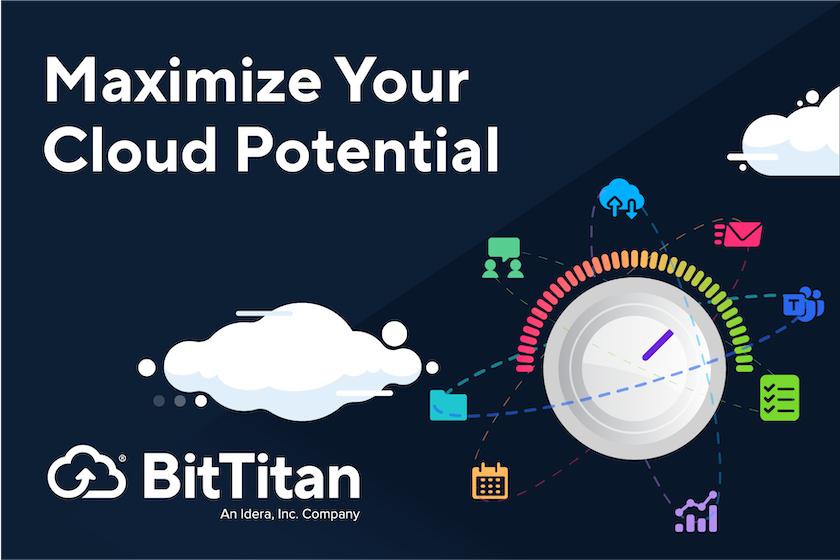Maximize Your Cloud Potential
New to the Cloud: 8 Tips for Making the Most of Your New Environment
Congratulations. You’ve decided to move your business to the cloud. You’ve done your research, gathered the right resources, and made your business case. Cloud technology has the potential to transform all aspects of your business. But the transformation
won’t happen automatically. It takes proactive planning and involvement of the entire organization to get the most out of your cloud infrastructure. And it starts with your people.
A good first step is making sure all employees understand how work is different in the cloud. But employees will also need different information based on their position and their responsibilities. Your IT team is going to need the most technical detail. They’ll want to have a good understanding of what’s going on ‘under the hood.’ Key individuals in the organization will need to know about administrative tools so they can carry out governance functions.
On the other hand, front-line employees will need to know how their applications will run differently and how to take advantage of new tools and automations. Collaborating teams will want to learn about the new ways of working that can help them increase their creativity and flexibility.
It can seem overwhelming at first. In fact, you may need to prioritize which cloud features you’re going to implement first. Your priorities will depend on your business. Decision criteria may include where your business is in its digital evolution, your employee needs, and your long- and short-term goals.
Maximize your cloud potential
As you implement your new cloud environment, here are eight tips for maximizing the long-term benefits for your business and employees:
- Bring employees along on the cloud journey. Be sure your employees understand how the cloud changes the way they will work. Use training and multiple communication channels to bring employees up to speed on best practices and how to stay safe. Some companies identify power users in different departments who can help their co-workers make the best of specific applications. You may also want to consider casual lunch-and-learns that highlight specific topics or pain points.
- Make sure your IT support knows your business. Don’t wait until something goes wrong to find a cloud-savvy IT support team. Many tech support services specialize in particular business types like professional services or retail. This allows them to not only consult on technical problems; they can recommend solutions based on what works for other companies in your line of business.
- Make the most of all that cloud storage. If your employees have been storing documents on local drives for years, it will take some time for them to get used to storing documents in the cloud. If you sense confusion or resistance, you may want to establish clear protocols that include an explanation of the benefits of vastly expanded storage space.
- Show what collaboration looks like. One of the most exciting benefits of moving to the cloud is the ability for teams to access their files and edit them together in real time. Platforms like Microsoft Teams integrate productivity apps that allow streamlined communication and collaboration, but like any new tool, people need to become comfortable with their use. Find ways to celebrate the teams that are benefitting from collaboration and recognize the ways their work is contributing to metrics like increased productivity and customer service.
- Make security a top priority. All users in your cloud environment should understand the seriousness of security protocols. While companies choose cloud environments because they’re known to provide better security, employees still need to play their part. With good governance, employees should only have access to data that’s applicable to their job, but they should still have clear guidelines for how to handle files safely. This is especially important as more and more companies are allowing for remote and hybrid work.
- Stay organized and prevent sprawl. Flexible cloud computing platforms provide many benefits, but they can quickly get messy if a clear organizing system isn’t established from the outset. Every individual has their own way of organizing their personal workspace. When it comes to shared files, a single system needs to take precedence or people will quickly become frustrated trying to find what they need. Setting clear organizing principles from the start can also help prevent a phenomena known as Teams sprawl, which can quickly result in dormant or unnecessary channels littered across the cloud landscape.
- Take advantage of cloud tools to do more. Yes, your company can do what they do better and more efficiently in a cloud environment. But they can also do so much more. With data out of separate silos and connected across teams, divisions, and even geographies, you can use powerful cloud services like machine learning and artificial intelligence to uncover insights and make more informed decisions. Intelligent data models can help you engage customers and provide more personalized, relevant services.
- Keep evolving. The cloud is always evolving and improving with new features and applications. You can stay on top of developments by attending conferences and reading white papers. Another strategy is to frequently ask leaders within your organization what they would like to do better or more efficiently. Find out from their perspective what activities could be streamlined to increase customer service or employee satisfaction. This will help you identify which cloud applications to prioritize on your roadmap.
BitTitan has moved thousands – and thousands – of companies to the cloud and we’ve learned a lot along the way. MigrationWiz is one of the top SaaS tools for migrations of any size and scope. And it’s backed with expert customer support and documentation. Congratulations on your decision to move to the cloud! Contact us to discover the best way to get there.


